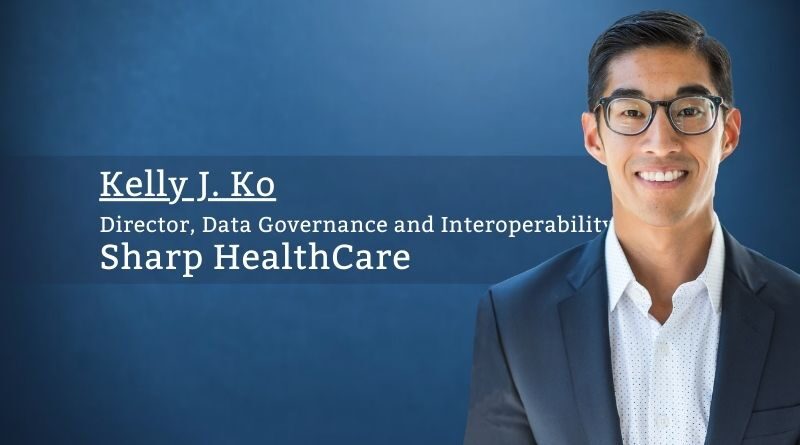Interoperability: Past, Present, and Future implications
By Maria Liu, M.S., Manager of Data Standards & Interoperability, Sharp HealthCare and Kelly J. Ko, Ph.D., Director, Data Governance and Interoperability, Sharp HealthCare

While the role of data in healthcare has no doubt been growing in recent years, one area that has remained elusive is information sharing, otherwise known as interoperability. Broadly defined by the Office of the National Coordinator (ONC), interoperability represents the ability of two or more systems to exchange and use the information. While the concept sounds simple enough, healthcare has struggled with this for various reasons, a few of which includes lack of consistent standards and complexity of data. Although we’ve made progress on the exchange of data, usability has been mixed. It also hasn’t helped that there has been a lack of federal guidance on the topic until recently with the 21st Century Cures Act and resulting Interoperability Final Rule.
How did we get here?
The concept of data exchanges dates back to the origins of the ONC during the George H.W. Bush administration which had the stated goal of facilitating nationwide information exchange. Initially, ONC focused on increasing the adoption of EHRs. However, along with electronic data came the expectation for electronic exchange and challenges in doing so became almost immediately clear.
In response, private industry, state governments, and healthcare innovators have all tried to address this challenge, albeit with mixed results. However, there is renewed hope with federal mandates which should help accelerate and extend the adoption of new technology and standards, but also incentivize payers, providers, and now 3rd party application developers to help get data back into the hands of patients and does so in 3 ways:
To be clear, federal legislation alone will not and is not aimed at solving all the challenges that come with interoperability but having clearer guidance will certainly help.
Data accessibility.
The ability to leverage data for decision-making first means it is even available to begin with. To achieve this, patients, providers, and payers–must have the ability to readily access data regardless of where care is and was received. Federal regulation calls for health plans and systems to have a public-facing application programming interface (API) to facilitate such requests.
Data ownership
The new regulations clearly indicate data belongs to the patient and patients have the authority to dictate when and with whom data is to be shared. For example, provided patient identity is verified and consent is received, patients can request their data be shared with whomever they choose, even non-healthcare entities.
Data standards
Recall, the definition of interoperability isn’t limited to simply sharing data, but the use of it once exchanged. Accessibility alone isn’t enough–data must be exchanged using a standard to help providers actually make use of data. The regulation attempts this by mandating providers, payers, and developers adopt a new standard (Fast Healthcare Interoperability Resources) to ensure data is exchanged in a consistent structure and format when called upon to do so.
Who is involved?
Although the majority of attention around interoperability and the 21st Century CURES Act has focused on technical requirements, we now also need to consider the role of 3rd party application developers. Traditionally, application development in healthcare has come from payers or health systems; we should now expect to see new entrants ranging from independent developers to big tech. Developers now have clearer guidance when developing tools to help patients request their data, and these new entrants will no doubt bring to market more consumer-friendly applications than what we’ve typically seen.
Where do we go from here?
As a first step, we need to acknowledge patient data just got a lot easier to move. As a result, healthcare organizations must prepare for greater demand for patient data and grow accustomed to seeing new tools being used to facilitate such requests. Furthermore, the number of Americans changing employers and health plans at a rate higher than previous years, lends itself to an expectation their data can and should follow as well.
Additionally, while patients will be empowered, payers and the health system can also take action. While federal legislation has emphasized making it easier for patients to access their data, it was also designed to help health systems and payers exchange data as well. For example, payers can request data from other payers (provided they have appropriate consent) for both prospective and new members.
Finally, let’s not forget about those with most at stake with interoperability, the patient. Any meaningful discussion around patient data must reference the risks of data sharing, especially using 3rd party applications. Considering the value of health records on the black market far outpaces that of other common sources such as credit card information, there is a clear need for increased attention to understanding and protecting against potential security risks.
Altogether, we are undoubtedly entering an exciting era for healthcare and technology that has been a long time coming. To be clear, federal legislation alone will not and is not aimed at solving all the challenges that come with interoperability but having clearer guidance will certainly help. Federal legislation coupled with increased patient expectations their data follows them, points towards the notion that it’s not an “if” but “when” and perhaps more importantly, how fast we adopt this new reality. Either way, the stage has been set for interoperability to realize more of its potential and how quickly patients, healthcare organizations and now 3rd party developers respond will pace our progress.



